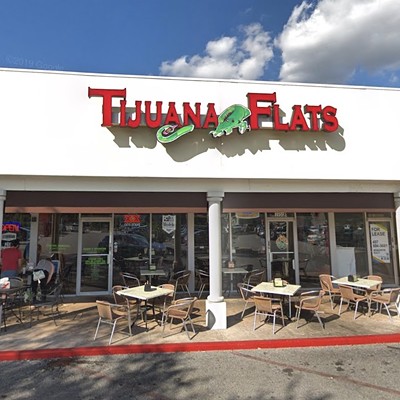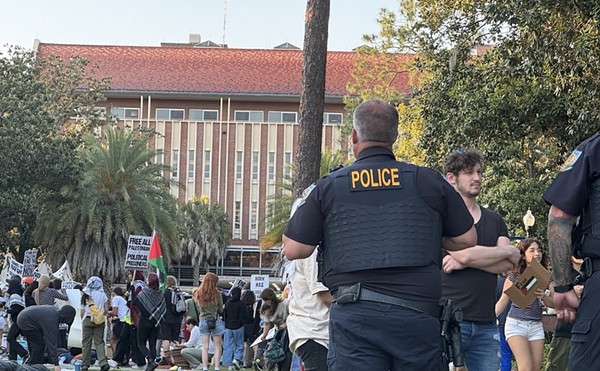Tamika Bryant says that letting her husband go play poker with his friends is the biggest regret of her life.
The 29-year-old Orlando woman had been married to Herman “Lil Man” Bryant, 31, for almost a year and a half, but they’d known each other since the two were just children attending a Boys and Girls Club in the Carver Shores neighborhood off Kirkman Road. They became romantically involved in 2001, after years of friendship through elementary and high school.
“We were off and on all those years, but we didn’t make it official until 2008,” Tamika recalls with a smile. The two were married on July 23, 2011.
“He had the greatest personality,” she said. “He could spark up a conversation with anyone he meets. He would have you laughing all day.”
Tamika worked as a corrections officer at the 33rd Street jail, and Herman owned a wing and sub shop called Bryant One Stop in a dilapidated neighborhood in West Orlando. It did quite well – enough for Tamika to plan on quitting her job, which she hated. The two wanted to start a home for troubled teens in their old stomping grounds.
Bryant, who was a Mason, was a simple guy. His father gave him his nickname because he was the “runt of the litter” in a family of six children. Even though Lil Man grew up to be rather large, everyone, even his wife, referred to him by his childhood moniker. He liked going to Clearwater Beach; he was a passionate cook; he loved spending time with his parents and siblings, as well as his four children; and he enjoyed playing poker.
On April 16, 2013, the couple spent the morning shopping at the Florida Mall in preparation for a trip to Miami. Tamika’s birthday was in two days, and in addition to enjoying the beach, the couple intended to scout out foster homes to develop some ideas for their own.
They went by Bryant One Stop and closed up shop by 9:15 p.m. Throughout the day, Lil Man mentioned attending a card game with his friends later that night. Tamika objected, but after the restaurant was closed, she eventually let him go.
She woke at 3:45 a.m. to an empty bed. Upset, she called her husband, who said to her, “Baby, I’ll be coming home in a minute. I love you.”
Those were the last words Herman Bryant spoke to his wife. By 4:30 a.m. a drive-by shooter had peppered the Cadogan Avenue house where the poker game took place, and while sitting at his friend’s table, Lil Man was shot in the head. He was pronounced dead hours later.
“I actually saw my husband dead at the funeral home,” Tamika said through her tears. “That was my birthday gift.”
Nearly a year later, Tamika still has no idea who killed her husband.
Of the 19 murders that occurred in Orlando during 2013, four of them are still unsolved, according to the Orlando Police Department. Herman Bryant’s is one.
This morbid fact might be softened by perceptions perpetuated by television and movies, which insinuate through a nightly stream of fictionalized shootouts, police chases and forensics breakthroughs that four unsolved homicides isn’t so bad.
But statistics tell a different story. In 2014, a data-collection website known as NeighborhoodScout.com labeled Orlando No. 81 in a list of the 100 most dangerous cities in the nation. It’s joined there by 10 other Florida cities, including Miami, Daytona Beach and Homestead (which was the most violent in the state, at No. 18 on the list).
The data are based on city population and crimes reported to the FBI by local agencies. According to the same website, residents here have a 1 in 13 chance of becoming a victim of either violent or property crime, and victims come at a rate of 78 per 1,000 residents.
With a population close to 250,000, Orlando is proportionately more violent than many cities of similar size. While the state of Florida averaged 487 violent crimes per 100,000 people, according to the FBI’s Uniform Crime Report Crime in the United States report for 2012, Orlando average more than 1,000 violent crimes per 100,000 people during that same period.
In the first six weeks of 2014, there were already a half-dozen homicides. Most of these killings have resulted in an arrest – police have five suspects in custody for these murders, to date – and Orlando Police Department spokesman Sgt. James Young notes that in an annual review, the Orlando Police Department found the city’s homicide rate had dropped 30 percent between 2012 and 2013. (There were eight more murders in 2012 than there were in 2013.)
Young attributes this trend to OPD’s efforts to remove “crime guns” from the street, harsher sentencing for career criminals and increased community involvement.
“The community-police partnerships are always effective in reducing crime,” Young said. He added that he wasn’t familiar with NeighborhoodScout.com or its numbers and therefore couldn’t provide an informed comment on Orlando’s low score on the site’s crime index. He did, however, point out that the department has a strong record when it comes to tracking down murderers. “It should be noted that OPD has a homicide solve rate of about 75 percent,” Young said. “The national average homicide solve rate is 62 percent.”
But for Tamika Bryant, those percentages mean little. She said that after a year of waiting, she’s frustrated. “I won’t say that it would give me closure,” she said, “but it would help knowing that my husband’s killer isn’t walking around free.”
Detectives from Orlando Police were kind and helpful, answering her phone calls and any questions she posed – “These are never just numbers to us, each is a person,” Young said. “Our detectives work diligently to solve these cases and provide answers to the victims’ families” – but Tamika has grown cynical now that so much time has passed without anyone answering for her husband’s death.
“You kind of lose faith after it’s been so long,” she said. “I kind of think that it’s been swept under the rug at this point. I mean, my husband’s murder will probably never be solved.”
After Lil Man was killed, police found a stolen van ditched and ablaze about a mile away on Edgemoor Avenue, as well as spent shell casings on nearby Cornelia Court from shots fired hours earlier. Detectives don’t know if it all connects, though.
“I think they know who the killer is,” Tamika said. “They just don’t have enough evidence to convict him. They mentioned that to me.”
Detectives told her the suspect is from a nearby neighborhood, but not much else, especially a motive. She said that Lil Man hadn’t been in a fight or an argument with anyone.
“I think they were targeting someone else there,” Tamika said. “It actually wasn’t for him. That’s why everyone took it so hard, because everyone is saying, ‘Of all the people who were in the house, why did the one good person there end up being the one who got shot?’”
Lil Man’s dead body was the first that Tamika had ever seen. The year 2013 was not kind to her: Her father-in-law died in January; her grandmother in February; her great-aunt two weeks later; Lil Man in April; and her father in May.
Later during the same month Lil Man was slain, his friends and family marched to Cadogan Avenue to hold a vigil, hoping to raise awareness and promote justice.
Lil Man’s brother, Anthony Bryant, said that they wanted answers. “We just want the detectives to have some help and people to just give them the information that they need, because it’s definitely hard on Mom, and it’s hard on the rest of us and his wife,” he told WESH-TV.
“All we want is justice,” Bryant’s mother said in a cracked, wavering voice.
“If you speak to someone else about my husband and I, we were together every day, 24/7,” Tamika said. “When I get off of work from the jail, I’m with him. We were at the restaurant. All my off days – we were together all day. So we were each other’s best friend. We were together all the time. It’s hard to pick up the pieces and go.”
Still, Tamika intends to go forward with the group home that she and Lil Man always envisioned. She plans to name it “Herman’s Helping Hands.”
“It was our dream, so I want to continue on with it,” she said.
When Lil Man died, his family tried to console her with the standard remarks: “It’s going to be OK,” and “God only takes you through things to make you stronger.”
But the words, just like the investigation into her husband’s death, seemed little more than weak and cursory.
“Everyone tried to talk to me and make sense of the situation,” Tamika said. “But to this day I still don’t understand the situation – I can’t understand it – because my best friend was taken away from me.”
Bryant One Stop no longer exists. Tamika Bryant had to give it up because of difficulties balancing the restaurant with her work as a corrections officer, a job she was forced to keep after her husband was killed.
A run-down food stop with a hand-drawn sign that says “Gyros, Fish & Chicken” has replaced the establishment where Bryant used to make his living. The owner is an Arab man who seems oblivious to the fate of the former manager.
“The guy who used to own this place gave it up some months back, and I bought it from the landlord about a month and a half ago,” he said.
He spoke from a small security window through which money and food are exchanged. A large banner hangs above the hatch. In bright red letters it states an unknowingly haunting message: “Under new management.”
In addition to Herman Bryant’s murder, Orlando police are still working to solve three other murder cases from 2013. Here are brief profiles of each of the other victims whose homicides are still unsolved.
Martin Martinez
Martinez (known as “Energy” by friends) was a 28-year-old Hispanic man who’d just started over in Orlando after losing his job loading containers at a port facility in Miami, according to a report by the Orlando Sentinel.
On Jan. 17, 2013, he was shot along with his girlfriend in his residence at NorthBridge Apartments on Estabrook Woods Drive, near the Mall of Millenia. His girlfriend lived, but Martinez was killed in the attack, which investigators characterized as a “home-invasion robbery.”
Police say the shooter was a thin black male around 5 feet, 10 inches tall, probably in his late 20s or early 30s, and wore a “dark bubble jacket, navy blue skullcap and Timberland boots.” He was assisted by a getaway driver in a white 2000 to 2007 Ford Taurus.
Another man was shot and killed the previous December at a complex next door (the Villages on Millenia), but police made two arrests in that case.
Martinez had roommates and was only living in the apartment temporarily. He’d only been in town for a month, so it seems one of four things happened: He made enemies quickly; trouble followed him from Miami; the gunman intended to target one of the other roommates; or this was just another senseless killing in the course of a robbery.
Martinez’s older brother, Alvaro Ferrey, told a local NBC affiliate that his brother was a decent person who was just looking for work.
“There’s so many different things that are flowing through my mind,” Ferrey said during a television interview in South Florida. “There’s not one thing that I could really say, you know, ‘This is what happened.’ I’m just very in pain with the circumstances, and I want justice to be served for my brother. I mean, he was a very caring person. He was at home. He wasn’t looking for trouble.”
Karl Bess
Karl Bess was a 31-year-old dreadlocked black man who lived in Orlando for eight years with his wife. He was a father of three and a full-time employee of a pool company. At around 10 p.m. on July 21, 2013, while attending the “Hype Reloaded” reggae event with some friends at Festival Field near the Citrus Bowl, Bess was beaten by six to 10 black males and stabbed multiple times. He died at the hospital.
According to OPD, his four-door blue 2006 Audi also went missing the night he was slain.
Bess’ family spoke out within a week of his death, and his mother’s tear-streaked face appeared on reports by WESH and WOFL pleading for witnesses to come forward.
“You don’t have to give your name. Please call. Just say what you saw. Say what you know,” Marie Bess begged.
At the time of his death, Bess’ children included two sons, 14 and 5 years old, and a 10-month-old daughter. His wife was crying too hard to say anything at the press conference, and his teenage son looked so straight-faced that he was either in shock or uncomprehending of the reality that his father was gone forever.
Elroy Bryant
Little is known about Elroy Bryant. He was a 32-year-old black man who had worked at Fuddruckers at some point before his demise, according to a message left on his obituary by a former manager.
He was shot to death on Aug. 31, 2013, while riding his bicycle on Tampa Avenue and Carter Street just south of the Citrus Bowl. His body was discovered in an adjacent field by a bystander who waved police down at around 4 a.m. Investigators said Bryant’s body had “obvious homicidal trauma.”
Sgt. Young told the Orlando Sentinel that the slaying might have been connected to a robbery that occurred two hours earlier at nearby Pine Street and Texas Avenue. The suspect in that crime was described as a 5-foot-10 to 6-foot black male of medium build, aged in his early- to mid-20s. He wore a red polo, a red baseball cap and black shorts.
Not much else is known about Bryant, except that he is survived by grandparents and other relatives. He was arrested in July 2010 for driving without a valid license, but that’s about it.
Bryant’s former boss at Fuddruckers, Javier Santos, wrote in Bryant’s online obituary that he worked with him for three years and that he had a friendly presence. “Elroy was a good man and I will always remember his big, bright smile that always illuminated any room he entered,” Santos recalled, before extending his sympathies.
Another guest, identifying herself merely as “Kelly,” posted her condolences in the form of a Bible quote. The passage was apt, and could have applied to any of the four cases. It was Acts, 24:15: “And they have hope toward God, which they themselves also allow, that there shall be a resurrection of the dead, both of the just and the unjust.”


















